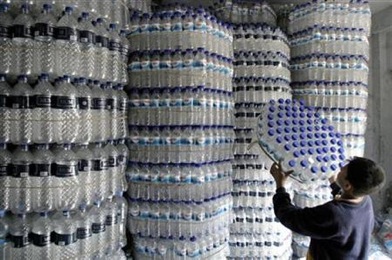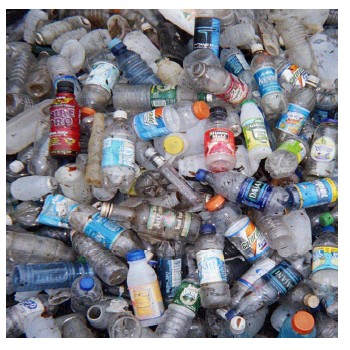The Fiji flap is a surreal poster-child for the global trafficking in bottled water. Ten local bottlers (#1 is Fiji Water) fill Chinese-manufactured bottles with Fijian well-water and ship them to the United States, which has an abundance of clean water. The Fijian government watched as its artesian wells are drained while many of its citizens lack access to clean water. This summer the government imposed an export tax of 20 cents/liter. The bottlers all shut down.
![]() As last week's World Water Week conference in Stockholm breaks up, in this post I try to make some sense of the bottled-water industry: (1) How did we get to Fiji? (2) Are the bottler brands being responsible? (3) What should consumers, and voters, do about the issue?
As last week's World Water Week conference in Stockholm breaks up, in this post I try to make some sense of the bottled-water industry: (1) How did we get to Fiji? (2) Are the bottler brands being responsible? (3) What should consumers, and voters, do about the issue?
1.How Did We Get to Fiji?
The biggest exporter of bottled water is France, which started the bottled-water trend with Perrier and Evian "mineral" waters, which were exported as spa products with health-giving properties. Restaurants liked them as a paying alternative to tap water. Bottled water then took off as a convenience for travelers and those engaged in strenuous activity, especially in hot weather. Evian and Fiji Water became top sellers. Bottlers promoted the idea that everyone should drink at least eight glasses of water a day, an admonition not based on science. We got to Fiji because it has a glamorous name and story to put on a bottle, and a taste to promote as a selling point and a price premium.
Carrying water on trips is not new. Animal skins and gourds are described by ancient writers as being used by travelers to carry water and wine. Canteens have for centuries been standard issue for soldiers. Today's bottled-water issues arise from the fact that the bottles are sold as single-use items with "No Refill" on the label:
-As a new graphic based on UN data shows, the United States is the world's main importer of bottled water. A relatively small number of countries like France, Italy and Fiji are exporters, based on their having spas or wells. Mexico and Brazil are major bottled-water users, but use in-country sources. Virtually no bottled water is imported by countries that need it most, in the southern hemisphere.
-It costs the earth in energy and resources to make and transport the bottles. In the process of drinking some four billion gallons of bottled water a year, Americans use 50 million plastic bottles, consuming two million barrels of oil in the process.
-Bottles end up as long-lasting (estimated life 700-1,000 years) plastic in municipal landfills (see left photo below) or as landscape litter or deadly ocean refuse (see right photo below).A tiny fraction of bottles are reused or recycled. Only 23 percent of U.S. polyethylene terephthalate (PET) bottles are said to be recycled, but the Container Recycling Institute (CRI) in 2007 says that single-serve PET plastic water bottles are much worse, with a U.S. recycling rate of only four percent, leaving about four billion PET bottles, two million tons worth, to go to landfills.

-It costs the consumer many times more than tap water. The American Water Works Association says people can get all the drinking water they need for less than $1 a year. Bottled water costs at least $400 a year for eight small bottles of water a day, much more if purchased in restaurants or convenience stores. In 2007, Americans paid $16 billion for their bottled water retail, rising at a double-digit rate, and about $12 billion wholesale.
-Between 25 and 40 percent of U.S. bottled water is just purified municipal tap water. Pepsi's top-selling Aquafina recently put a tap-water-origin notice on its bottle label after negative publicity from Corporate Accountability (Coca-Cola's Dasani is also tap water). Average tap water is at least as safe as average bottled water - the U.S. EPA maximum contaminant standards for tap water, enforced by states, have been more stringent than FDA standards for bottled water. The water-bottling industry (IBWA) has created its own standards that are higher in some respects than the EPA or FDA, but enforcement depends on bottlers hiring independent certifiers like Underwriters Lab, which opened up for business in this area only a few months ago.
2.Are the Bottler Brands Being Responsible?
The bottled-water industry has a different perspective. It sees water as a competitor to high-calorie, artificially flavored sodas. Bottlers are racing to bring to market new beverages that take advantage of today's concerns about (1) obesity, (2) natural foods and beverages, (3) the environment. Here are some recent developments:
- Aroma Water - uses aromatic closures called "ScentSational Caps" to deliver a fruit flavor.
- Ayala's Herbal water - infuses a variety of herbs into bottled water; was recently certified organic.
- Bot Beverages - offers fortified water for children.
- Cadbury-Schweppes - introduced Snapple LYTe Water and Antioxidant Water.
- Coca-Cola - acquired Vitaminwater, Energywater and Smartwater.
- Hansen's Natural - launched Organic Junior Water flavored with juice.
- Old Orchard brand - selling a vitamin water for FruitSense.
- Pepsi - reworked its Aquafina Alive and SoBE Life Water brands.
- Skinny Water - recently introduced Açaí Grape Blueberry (Hi-Energy).
- Water Joe - offers Artisan spring water that includes a shot of caffeine extracted from coffee beans.
It's mostly bottled water with a flavor and something else. We could make most of it at home for a fraction of the cost. But compared with soda, it's a great improvement, especially if it's what our kids are being offered in school and college.
The other main tack bottlers are taking is to tackle the environmental issues head-on. Fiji Water has attempted to estimate its carbon footprint. Some companies use "eco-bottles" with 30 percent less plastic, for example, Pepsi's Aquafina, Coca-Cola's Dasani and Nestlé Waters' brands - Poland Spring, Ozarka and Arrowhead. Pepsi is also introducing a light non-carbonated beverage bottle with 20 percent less plastic, which it says will save some 20 million pounds of plastic a year from landfills. Poland Spring advertises its Eco-Shaped Bottle as "Not Just Another Pretty Bottle", you may think: "Well, the reduced-plastic bottle will still end up in U.S. landfills. But 70 percent is better than 100 percent.
Other ideas that have been introduced are biodegradable plastic - PrimoWater makes its single-serve bottles from corn-based Ingeo PLA - or a canteen-shaped bottle from SEI water.
Environmentalists believe corporations should be doing more than this. But meanwhile, bottlers sell water to make a living, the same way barbers cut hair, and the product - unlike cigarettes, for example - can be lifesaving.
3.What Should We Consumers Do about These Problems?
Here are some suggestions for consumers:
Lobby Your Local Officials. Cities provide free or cheap water and pay for the extra costs of discarded plastic bottles. They have a stake in reducing bottled-water sales. Encourage your elected officials to
- campaign for the taste and health value of tap water (New York City recently won a water quality tasteoff),
- forbid bottled water in city buildings or at city events,
- require restaurants either to offer tap water explicitly or else remove bottled water from menus,
- review tax or bottle-deposit laws to discourage use of single-use bottled water.
U.S. cities with initiatives like this include New York, Los Angeles, Chicago, San Francisco, Seattle, Salt Lake City, Santa Barbara, and Ann Arbor.
Buy Home Filters. If you are concerned about the quality of your tap water, buy a filter:
- A Brita pitcher has a built-in filter.
- For each Brita filter sold at with a $10 refillable bottle by Nalgene, a portion of proceeds goes to the Blue Planet Run Foundation.
- Procter & Gamble offers a Pur faucet-mounted water filters, with the claim that one filter is good for filling 3,200 16-oz. water bottles and saves users $600-$1,000/year.
Reuse Water Bottles. Tips:
- Ignore the "NO REFILL" notices on bottles, which is the manufacturers' way of saying they don't want the bottles back.
- Look for plastic water bottles made with PET (the bottles have a triangle at the base with a 1 in it).
- Wash thoroughly and dry upside down between use because bacteria thrive in warm, moist environments.
- Avoid bottles containing Bisphenol A (BPA), which can be released, particularly if the product is heated. Most single-use water bottles sold in the United States are made from BPA-free plastic.
- Buy a refillable bottle from Tappening (), which also sells refillable bottles that are durable, stylish and dishwasher safe; some have a filter built in.
- Sigg (www.siggstore.com) is a Swiss maker of 140 designs of lightweight reusable drinking bottles. Its $15-to-$20 bottles are sold by Whole Foods, L.L. Bean and Bottled Water Blues.
Support Nonprofits Working on These Issues. The Natural Resources Defense Council, Sierra Club and the World Wildlife Fund have all recommended we consume less water. Three nonprofits are focusing aggressively on freshwater conservation issues:
- The Nature Conservancy,
- The Pacific Institute and
- The Australian-based Water Stewardship Initiative, represented by One World Standards.
They sponsor the Alliance for Water Stewardship (AWS), which just concluded "fruitful" meetings at the World Water Week conference and will sponsor a stakeholder forum in Melbourne at the end of September. After that, the AWS intends to start drafting standards and will then pilot-test them in 2009. The President of the Pacific Institute, Peter Gleick, is reportedly near completion of a much-awaited book on the bottled-water industry.
![]() THE GREEN EDGE Every generation should be willing to make sacrifices to ensure that the planet is delivered safely to generations that follow. The challenge for Americans today is to reduce our dependence on foreign oil and to halt the impairment of our land, water and air by wasteful production and consumption practices. We must change our behavior as consumers and as corporations. Our nonprofits, governments and media should be leading the way. The Green Edge looks at what, how and why we must change.
THE GREEN EDGE Every generation should be willing to make sacrifices to ensure that the planet is delivered safely to generations that follow. The challenge for Americans today is to reduce our dependence on foreign oil and to halt the impairment of our land, water and air by wasteful production and consumption practices. We must change our behavior as consumers and as corporations. Our nonprofits, governments and media should be leading the way. The Green Edge looks at what, how and why we must change.
(Thanks to Patt Cottingham for preparing the "Green Edge" logo, for selecting the photos and for her valuable suggestions incorporated in this post.)